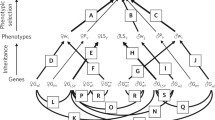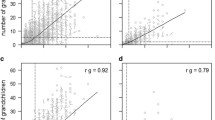Abstract
Implications of variance in the time at which sibs become mature are considered, particularly with respect to the fragmentation of a parental genome over time. It is concluded that regardless of the adaptive derivation of various intra-sibship maturation schedules, they each have important genetic consequences.
Similar content being viewed by others
References
Bayreuther, K. (1969). Die Cytogenetik zweier norddeutscher Populationen von Nosopsyllus fasciatus Bose (Aphaniptera). - Chromosoma 27, p. 20–24.
Bodmer, W.F. (1970). The evolutionary significance of recombination in prokaryotes. - Symp. Soc. General Microbiol. 20, p. 279–294.
Bodmer, W.F. (1972). The evolution of recombination mechanisms in bacteria. - In: Ledoux, L. (ed.) Uptake of informative molecules by living cells. - Amsterdam, North-Holland Publ. Co., p. 130–140.
Burley, N. (1980). Clutch overlap and clutch size: alternative and complementary reproductive tactics. Amer. Nat. 115, p. 223–246.
Charnov, E.L. & W.M. Schaffer (1973). Life history consequences of natural selection: Cole's result revisited. - Amer. Nat. 107, p. 791–793.
Cleland, R.E. (1968). Cytogenetic studies on Oenothera, subgenus Raimannia. - Jap. J. Genet. 43, p. 329–334.
Cleland, R.E. (1972). Oenothera: Cytogenetics and evolution. - New York Academic Press.
Cohen, D. (1966). Optimizing reproduction in a randomly varying environment. - J. theor. Biol. 12, p. 119–129.
Cohen, D. (1967). Optimizing reproduction in a randomly varying environment when a correlation may exist between the conditions at the time a choice has to be made and subsequent outcome. J. theor. Biol. 16, p. 1–14.
Cohen, D. (1968). A general model of optimal reproduction in a randomly varying environment. - J. Ecol. 56, p. 219–228.
Cole, L.C. (1954). The population consequences of life history phenomena. - Quart. Rev. Biol. 29, p. 103–137.
Cook, R.E. (1979). Asexual reproduction: a further consideration. - Amer. Nat. 113, p. 769–772.
Den Boer, P.J. (1968). Spreading of risk and stabilization of animal numbers. - Acta biotheor., 18, p. 165–194.
Dingle, H., B.M. Alden, N.R. Blakley, D. Kopec & E.R. Miller (1980). Variation in photoperiodic response within and among species of milkweed bugs (Oncopeltus). - Evolution 34, p. 356–370.
Eshel, I. & M.W. Feldman (1970). On the evolutionary effect of recombination. - Theor. Pop. Biol. 1, p. 88–100.
Fisher, R.A. (1930). The genetical theory of natural selection. - Oxford, University Press.
Fontana, F. & M. Amorelli (1978). Chromosomal translocations in 2 Italian populations of Reticulitermes lucifugus (Insecta: Isoptera: Rhinotermitidae). - Experientia (Basel) 34, p. 708–709.
Gadgil, M. & W. Bossert (1970). Life history consequences of natural selection. - Amer. Nat. 104, p. 1–24.
Gadgil, M. & O.T. Solbrig (1972). The concept of r and K selection: evidence from wild flowers and some theoretical considerations. - Amer. Nat. 106, p. 14–31.
Hamilton, W.D. (1964a). The genetical evolution of social behaviour. I. - J. theor. Biol. 7, p. 1–16.
Hamilton, W.D. (1964b). The genetical evolution of social behaviour. II. - J. theor. Biol. 7, p. 17–52.
Hubbell, S.P. & P.A. Werner (1979). On measuring the intrinsic rate of increase of populations with heterogeneous life histories. - Amer. Nat. 113, p. 277–293.
Istock, C.A., J. Zisfein & K. Vavra (1976). Ecology and evolution of the pitcherplant mosquito. 2. The substructure of fitness. - Evolution 30, p. 535–547.
James, S.H. (1970). Complex hybridity in Isotoma petraea II. Components and operation of a possible evolutionary mechanism. - Heredity 25, p. 53–77.
Koller, B. (1969). The physiology of dormancy and survival of plants in desert environments. - Symp. Soc. exp. Biol. 23, p. 449–469.
Lewontin, R.C. (1974). The genetic basis of evolutionary change. - New York & London, Columbia Univ. Press, xi +346 pp.
MacArthur, R.H. & E.O. Wilson (1967). The theory of island biogeography. - Princeton, N.J., Princeton Univ. Press, xi + 203 pp.
Mayer, A.M. & A. Poljakoff-Mayber (1975). The germination of seeds. - London, Permagon Press.
Maynard-Smith, J. (1978). The evolution of sex. - Cambridge, England, Cambridge Univ. Press, x + 222 pp.
Mountford, M.D. (1971). Population survival in a variable environment. - J. theor. Biol. 32, p. 75–79.
Mountford, M.D. (1973). The significance of clutch-size. - In: Bartlett, M.S. & R.W. Hiorns, eds., The mathematical theory of the dynamics of biological populations, N.Y., Academic Press, p. 315–323.
Murdoch, W.W. (1966). Aspects of the population dynamics of some marsh Carabidae. - J. Anim. Ecol. 35, p. 127–156.
Murphy, G.I. (1968). Pattern in life history and the environment. - Amer. Nat. 102, p. 391–404.
Ogawa, K. (1954). Chromosome studies on the Myriapoda, VII. A chain-association of the multiple sex-chromosomes found in Otocryptops sexspinous (Say). - Cytologia 19, p. 265–272.
Ogawa, K. (1961). Chromosome studies in the Myriapoda, XIII. Three types of the sex-chromosomes found in Otocryptops rubiginosous (L. Koch). - Jap. J. Genet. 36, p. 122–128.
Pianka, E.R. (1970). On r- and K-selection. - Amer. Nat. 104, p. 592–597.
Pianka, E.R. (1972). “r” and “K” or “b” and “d” selection? - Amer. Nat. 106, p. 581–588.
Roberts, E.H. (1972). Variability of seeds. - London, Chapman & Hall.
Schaffer, W.M. (1974a). Selection for optimal life histories: the effects of age structure. - Ecology 55, p. 291–303.
Schaffer, W.M. (1974b). Optimal reproductive effort in fluctuating environments. - Amer. Nat. 108, p. 783–790.
Sebens, K.P. (1979). The energetics of asexual reproduction and colony formation in benthic marine invertebrates. - Amer. Zoologist 19, p. 683–697.
Syren, R.M. & P. Luykx (1977). Permanent segmental interchange complex in the termite Incisitermes schwarzi. - Nature 266, p. 167–168.
Templeton, A.R. & D.A. Levin (1979). Evolutionary consequences of seed pools. - Amer. Nat. 114, p. 232–249.
Treisman, M. & R. Dawkins (1976). The “cost of meiosis”: is there any? - J. theor. Biol. 63, p. 479–484.
Virkki, N. (1968). A chiasmate sex quadrivalent in the male of an alticid beetle, Cyrsylus volkameriae (F.) - Canad. J. Genet. Cytol. 10, p. 898–907.
Warner, R.R. (1978). Sexual — asexual evolutionary equilibrium. - Amer. Nat. 112, p. 960–962.
Williams, G.C. (1975). Sex and evolution. - Princeton, N.J., Princeton Univ. Press, x + 200 pp.
Williams, G.C. & J.B. Mitton (1973). Why produce sexually? - J. theor. Biol. 39, p. 545–554.
Wright, S. (1956). Modes of selection. - Amer. Nat. 90, p. 5–24.
Author information
Authors and Affiliations
Rights and permissions
About this article
Cite this article
Thorne, B.L. Genetic consequences of variation in sib maturation schedules. Acta Biotheor 30, 219–227 (1981). https://doi.org/10.1007/BF00051768
Received:
Issue Date:
DOI: https://doi.org/10.1007/BF00051768




